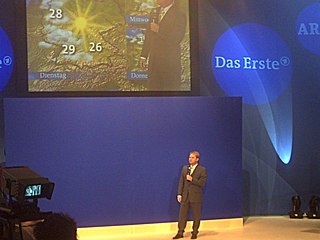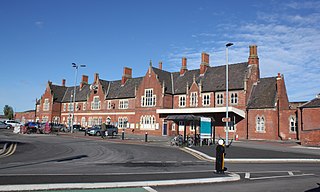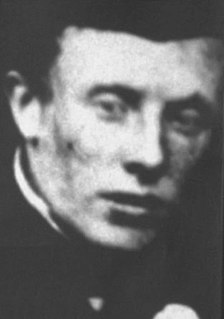
The Ross-on-Wye weather station is a weather station, now fully automated, situated off the Walford Road in Ross-on-Wye, Herefordshire, England. Coordinates: 51°54′40″N2°35′09″W / 51.91111°N 2.58575°W

The Ross-on-Wye weather station is a weather station, now fully automated, situated off the Walford Road in Ross-on-Wye, Herefordshire, England. Coordinates: 51°54′40″N2°35′09″W / 51.91111°N 2.58575°W
Throughout the Second World War, it was the only volunteer-run weather station to be accepted by the Met office. Every night throughout the conflict, it was the only land-locked station to be included in the shipping forecast on the World Service. The anecdotes goes that- even when in the Pacific- the soldiers from Ross would know exactly what the weather was like around at their mothers.
Clement Grant Dixon, Physics teacher, Ross Grammar School, 1970.
Henry Southall (1836-1916), set up a station at 'The Craig, Ross' in 1859. [1] It was in 1860, after the loss of the Royal Charter in 1859, that Robert FitzRoy (1805–1865) used the electric telegraph to transmit weather data so he might issue storm warnings and in 1861 issue weather forecasts. Importantly Ross was already operating. [2]
Frederick James Parsons arrived in Ross in 1912 having previously had his own amateur station when a child. He met up with Southall, and established his own station at Chase Dale in the Chase, Ross. In 1914 he was made a Fellow of Royal Meteorological Society but due to the outbreak of war he joined the Herefordshire Territorials and was transferred to the Royal Engineers as one of the first five meteorologists to be in the service. The station was maintained in his absence by the landowner, Mrs Purchase. On return he continued to take daily readings until 1964 when he was 72. [1]
From 1975 until 1985 the town was without a weather station, but on the initiative of the mayor, Arthur Clarke, it was reopened in May 1985. [3]
More recently readings were taken by Howard Ellis, a retired chemist assisted by the husband and wife team, June and Rex Swallow. June Swallow took over the monitoring station in 1995 and continued to take readings until the Summer 2008 when she retired after 23 years. [1] The station was semi-automated but still needed volunteers to take some readings. [3] [4]
In October 2017 the station was fully automated. [3]
Henry Southall was a distinguished meteorologist, a Fellow of Royal Meteorological Society who served as its president. In December 1895, he read his paper on the "Floods in the West Midlands" in which he considered the great floods that had occurred on the rivers Severn, Wye, Usk and Avon. He took data from the River Wye at Ross. He used a rise of 14 feet 6 inches (4.42 m)as measure of a 'primary flood'. He wrote that all the great floods occurred in November and February, and their frequency was decreasing. This he attributed to better drainage in the lower reaches and railway embankments and bridges holding back the surge from the upper reaches. He noted that rainfall had not decreased and he had taken the readings. [1]
The floods at Ross were in
The station has these instruments:

Meteorology is a branch of the atmospheric sciences which includes atmospheric chemistry and atmospheric physics, with a major focus on weather forecasting. The study of meteorology dates back millennia, though significant progress in meteorology did not occur until the 18th century. The 19th century saw modest progress in the field after weather observation networks were formed across broad regions. Prior attempts at prediction of weather depended on historical data. It was not until after the elucidation of the laws of physics and more particularly, the development of the computer, allowing for the automated solution of a great many equations that model the weather, in the latter half of the 20th century that significant breakthroughs in weather forecasting were achieved. An important domain of weather forecasting is marine weather forecasting as it relates to maritime and coastal safety, in which weather effects also include atmospheric interactions with large bodies of water.

Hereford is a cathedral city, civil parish and the county town of Herefordshire, England. It lies on the River Wye, approximately 16 miles (26 km) east of the border with Wales, 24 miles (39 km) southwest of Worcester, and 23 miles (37 km) northwest of Gloucester. With a population of 60,800, it is by far the largest settlement in Herefordshire.

Weather forecasting is the application of science and technology to predict the conditions of the atmosphere for a given location and time. People have attempted to predict the weather informally for millennia and formally since the 19th century. Weather forecasts are made by collecting quantitative data about the current state of the atmosphere, land, and ocean and using meteorology to project how the atmosphere will change at a given place.

Meteorologists are scientists who study and work in the field of meteorology. Those who study meteorological phenomena are meteorologists in research while those using mathematical models and knowledge to prepare daily weather forecast are called weather forecasters or operational meteorologists.

A weather station is a facility, either on land or sea, with instruments and equipment for measuring atmospheric conditions to provide information for weather forecasts and to study the weather and climate. The measurements taken include temperature, atmospheric pressure, humidity, wind speed, wind direction, and precipitation amounts. Wind measurements are taken with as few other obstructions as possible, while temperature and humidity measurements are kept free from direct solar radiation, or insolation. Manual observations are taken at least once daily, while automated measurements are taken at least once an hour. Weather conditions out at sea are taken by ships and buoys, which measure slightly different meteorological quantities such as sea surface temperature (SST), wave height, and wave period. Drifting weather buoys outnumber their moored versions by a significant amount.

The River Wye is the fourth-longest river in the UK, stretching some 250 kilometres from its source on Plynlimon in mid Wales to the Severn estuary. For much of its length the river forms part of the border between England and Wales. The Wye Valley is designated an Area of Outstanding Natural Beauty. The Wye is important for nature conservation and recreation but is severely impacted by pollution.

The National Weather Service (NWS) is an agency of the United States federal government that is tasked with providing weather forecasts, warnings of hazardous weather, and other weather-related products to organizations and the public for the purposes of protection, safety, and general information. It is a part of the National Oceanic and Atmospheric Administration (NOAA) branch of the Department of Commerce, and is headquartered in Silver Spring, Maryland, within the Washington metropolitan area. The agency was known as the United States Weather Bureau from 1890 until it adopted its current name in 1970.

The Meteorological Office, abbreviated as the Met Office is the United Kingdom's national weather service. It is an executive agency and trading fund of the Department for Business, Energy and Industrial Strategy led by CEO Penelope Endersby, who took on the role as Chief Executive in December 2018, the first woman to do so. The Met Office makes meteorological predictions across all timescales from weather forecasts to climate change.

Ross-on-Wye is a market town with a population of 10,582 according to the 2011 census, estimated at 11,309 in 2019. It lies in south-eastern Herefordshire, England, on the River Wye, and on the northern edge of the Forest of Dean.

Herefordshire is a county in the West Midlands of England, governed by Herefordshire Council. It is bordered by Shropshire to the north, Worcestershire to the east, Gloucestershire to the south-east, and the Welsh counties of Monmouthshire and Powys to the west.

A weather presenter is a person who presents the weather forecast daily on radio, television or internet news broadcasts. Using diverse tools, such as projected weather maps, they inform the viewers of the current and future weather conditions, explain the reasons underlying this evolution, and relaying to the public any weather hazards and warnings issued for their region, country or larger areas. There are no basic qualifications to become a weather presenter; depending on the country and the media, it can range from an introduction to meteorology for a television host to a diploma in meteorology from a recognized university. Therefore a weather presenter is not to be confused with a meteorologist, or weather forecaster, the holder of a diploma in meteorology.

Hereford railway station serves the city of Hereford, England. Managed by Transport for Wales, it lies on the Welsh Marches Line between Leominster and Abergavenny, is the western terminus of the Cotswold Line and also has an hourly West Midlands Trains service from Birmingham New Street. The station has four platforms for passenger trains and two additional relief lines for goods services.

The Philippine Atmospheric, Geophysical and Astronomical Services Administration is the National Meteorological and Hydrological Services (NMHS) agency of the Philippines mandated to provide protection against natural calamities and to insure the safety, well-being and economic security of all the people, and for the promotion of national progress by undertaking scientific and technological services in meteorology, hydrology, climatology, astronomy and other geophysical sciences. Created on December 8, 1972, by reorganizing the Weather Bureau, PAGASA now serves as one of the Scientific and Technological Services Institutes of the Department of Science and Technology.

The Norwegian Meteorological Institute, also known internationally as MET Norway, is Norway's national meteorological institute. It provides weather forecasts for civilian and military uses and conducts research in meteorology, oceanography and climatology. It is headquartered in Oslo and has offices and stations in other cities and places. It has around 500 full-time staff and was founded in 1866.

Meteorological instruments or Weather instruments are the equipment used to find the state of the atmosphere at a given time. Each science has its own unique sets of laboratory equipment. Meteorology, however, is a science which does not use much laboratory equipment but relies more on on-site observation and remote sensing equipment. In science, an observation, or observable, is an abstract idea that can be measured and for which data can be taken. Rain was one of the first quantities to be measured historically. Two other accurately measured weather-related variables are wind and humidity. Many attempts had been made prior to the 15th century to construct adequate equipment to measure atmospheric variables.

The Pakistan Meteorological Department (PMD), is an autonomous and independent institution tasked with providing weather forecasts and public warnings concerning weather for protection, safety and general information.

The following outline is provided as an overview of and topical guide to the field of Meteorology.

Surface weather observations are the fundamental data used for safety as well as climatological reasons to forecast weather and issue warnings worldwide. They can be taken manually, by a weather observer, by computer through the use of automated weather stations, or in a hybrid scheme using weather observers to augment the otherwise automated weather station. The ICAO defines the International Standard Atmosphere (ISA), which is the model of the standard variation of pressure, temperature, density, and viscosity with altitude in the Earth's atmosphere, and is used to reduce a station pressure to sea level pressure. Airport observations can be transmitted worldwide through the use of the METAR observing code. Personal weather stations taking automated observations can transmit their data to the United States mesonet through the Citizen Weather Observer Program (CWOP), the UK Met Office through their Weather Observations Website (WOW), or internationally through the Weather Underground Internet site. A thirty-year average of a location's weather observations is traditionally used to determine the station's climate. In the US a network of Cooperative Observers make a daily record of summary weather and sometimes water level information.

The Hereford, Ross and Gloucester Railway, was a railway which ran for 22+1⁄2 miles (36.2 km) linking Hereford and Gloucester via Ross-on-Wye. It was opened on 1 June 1855 as a 7 ft 1⁄4 in broad gauge line, it was amalgamated with the Great Western Railway in 1862. In 1869 the railway was converted to 4 ft 8+1⁄2 in standard gauge. The railway was closed to passengers on 2 November 1964, freight services between Ross-on-Wye railway station and Grange Court railway station continued on until 1 November 1965.

William Clement Ley was an English clergyman and pioneer meteorologist who studied clouds and examined their dynamics and use in weather forecasting.